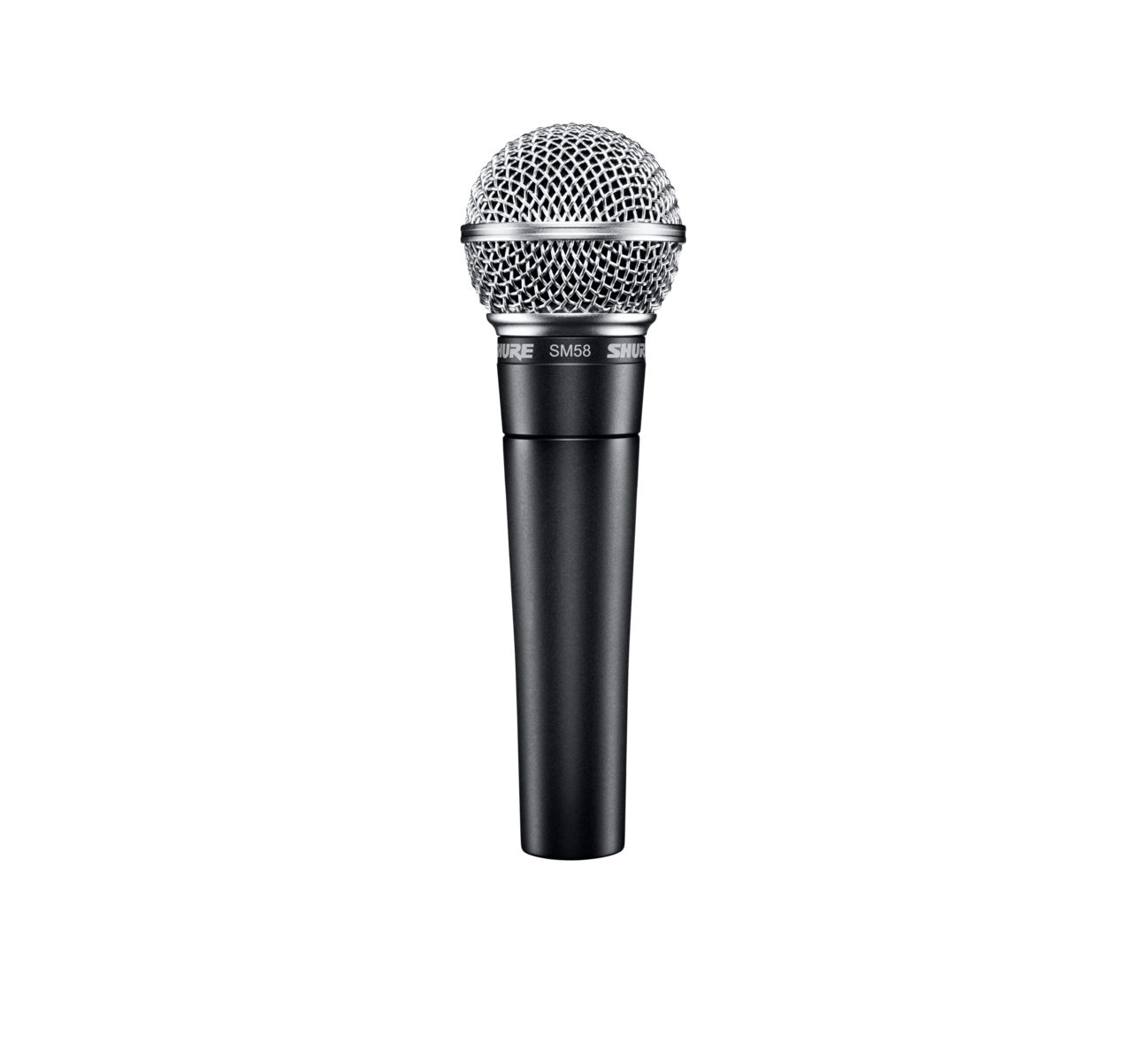We Celebrate SM58 Day on 5/8!
The Shure SM58 has become the touchstone for a professional vocal microphone, perfect in form, function, and feel. For many musicians, it is the only microphone needed for their entire career. Everywhere people make music, and for almost as long as music has been amplified, the SM58 has been "what you sing through." If any product has ever earned the title of "worldwide industry standard," surely the SM58 is it.

Wednesday, 5 August 2020: SM58 DAY
5th August is a day of celebration for the SM58 Dynamic Vocal Microphone.
The SM line, which originally was short for Studio Microphone, was first developed in the 1960s, and were aimed at the TV studio market, with a non-reflective finish and no on/off switch. Rock and roll sound engineers discovered the SM58 and SM57 in the late 1960s, and made these models famous worldwide as onstage performance microphones.
From the rigors of touring to attempting various ways of destroying them, the SM58 can take a beating, and it’s no wonder why musicians trust this legendary microphone.
Purchase your SM58 Online

SeeHearLive

Shure Lazada
Also Available at These Stores
Hung Brothers Electrical Trading
Sim Lim Square
1 Rochor Canal Road
Sim Lim Square #03-83
Singapore 188504
Luther Music Pte Ltd
Excelsior Shopping Centre
5 Coleman Street
#02-14/16/26
Singapore 179805
Wai Lian Electronics Pte Ltd
Showroom 1 @ Sim Lim Square
Sim Lim Square
1 Rochor Canal Road
Sim Lim Square #01-28
Singapore 188504
10 Things You Did Not Know About the SM58
#1 The "SM" in SM58 stands for "Studio Microphone."
Shure microphones had been a fixture in the public address market for nearly three decades when Shure executives saw growth potential in the radio and television broadcast markets of the early 1960s. This led to the development of the SM microphone series. The SM57 (1965) and SM58 (1966) were based on the popular Unidyne® III 545 (1959) used for public address systems. These new SM models were intended for broadcast studio use, eliminating the on-off switch and featuring a non-reflective, dark gray finish.
#2 The SM58 faced extinction in 1970
A single competitor was so entrenched in the broadcast market that radio and television stations weren't excited about the new Shure SM microphones. Sales were sluggish, and plans were afoot to discontinue the SM58 and the SM57. As a last-ditch effort, the Shure national sales manager suggested introducing the mics to live sound engineers in Las Vegas. The mics were a hit in Vegas, and entertainers began to embrace these models for live performance. As they say, the rest is history.
#3 Add a meshed ball grille to the SM57, and you have the SM58
Both models are based on the Unidyne III cartridge design developed by Shure engineer Ernie Seeler in the late 1950s. The primary difference between the SM57 and the SM58 is the grille design. The SM58 was designed for vocal applications, utilizing a ball grille that acts as an effective P-pop filter. The SM57 was designed primarily as an instrument microphone where a smaller grille size is preferred. In this application, P-pop is not a concern.
#4 You can turn it up to 11. Maybe even 12
How much SPL can the SM58 handle? At what point will the sound distort? The answer is much higher than would be safe for your ears: somewhere in the 150 to 180 dB SPL level, close to the noise level of a space shuttle launch. A well-designed dynamic like the SM58 is unlikely to reach its distortion point under normal circumstances.
#5 Zero gravity is no challenge for the SM58
In a video interview with The New York Times in April 2011, a wired SM58 is floating around and being shared by six astronauts on the International Space Station. It sounded great, and it provided a testing opportunity even Shure engineers could not have performed on Earth: the SM58's performance characteristics when weightless.
#6 Ernie Seeler, the man behind the development of the SM58, didn't like rock and roll
It's ironic that a quiet man who preferred classical music invented a mic that would become synonymous with rock and roll, first capturing the attention of acts like The Who and The Rolling Stones. Shocked by its widespread adoption on the rock stage, Ernie Seeler said, "I love classical music, but rock and roll, I don't take very seriously."
#7 The SM58 was born to perform. In fact, it's practically indestructible
The SM58 has been part of many shocking stories. We've heard of SM58s being ran over, used as hammers, or just dropped from tall heights. But they stand up to these tests. Ernie Seeler first tested the Unidyne III cartridge back in the 1960s by dropping, cooking, freezing, and submerging it. We can all thank the Shure Quality Assurance standards for its unfailing durability 50 years later.
#8 The SM58 capsule is still #1 in Shure wireless
Currently, there are fourteen microphone capsules available for Shure wireless microphone systems. They range from the affordable PGA58 dynamic element to the new KSM8 Dualdyne™. Due to popular demand, the SM58 capsule is available for every one of the eleven Shure wireless lines.
#9 The internal acoustic design of the SM58 can be traced back to the Unidyne Model 55 introduced in 1939
All Shure unidirectional cardioid microphones employ the revolutionary Uniphase acoustical network that engineer Ben Bauer began developing in 1937 and used in the Unidyne Model 55 microphone (1939.) Ernie Seeler advanced this technology in the 1950s by designing an end-address microphone with an internal pneumatic shock mount, the Unidyne III. The SM58 has a Unidyne III cartridge.
#10 A variety of artists have turned this mic into an icon
The SM58 has been the microphone of choice for Roger Daltrey, Paul McCartney, Henry Rollins, Patti Smith, Alice Cooper, Buddy Guy, Cheap Trick, G. Love, Martina McBride, Megadeth and countless other musicians. In fact, it would be difficult to name a major entertainer who has not used the SM58 at some time in their career.





